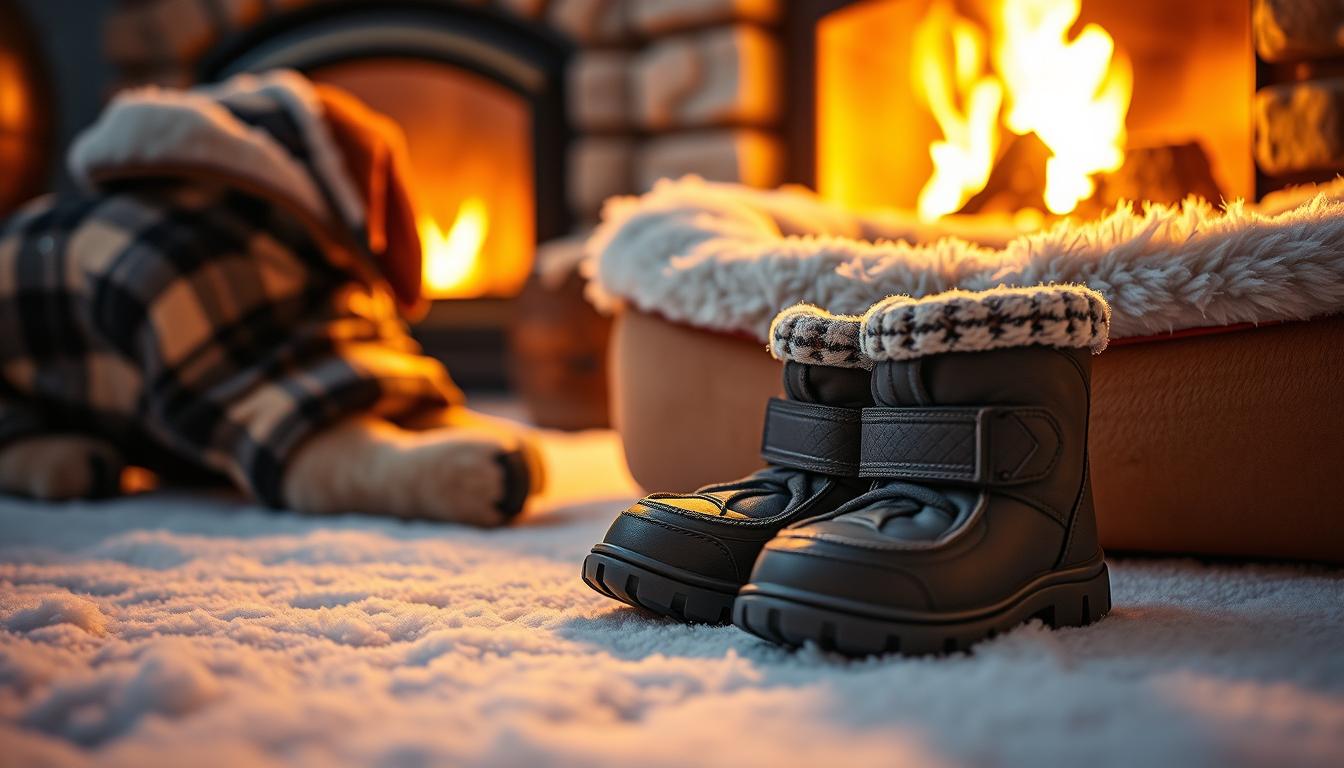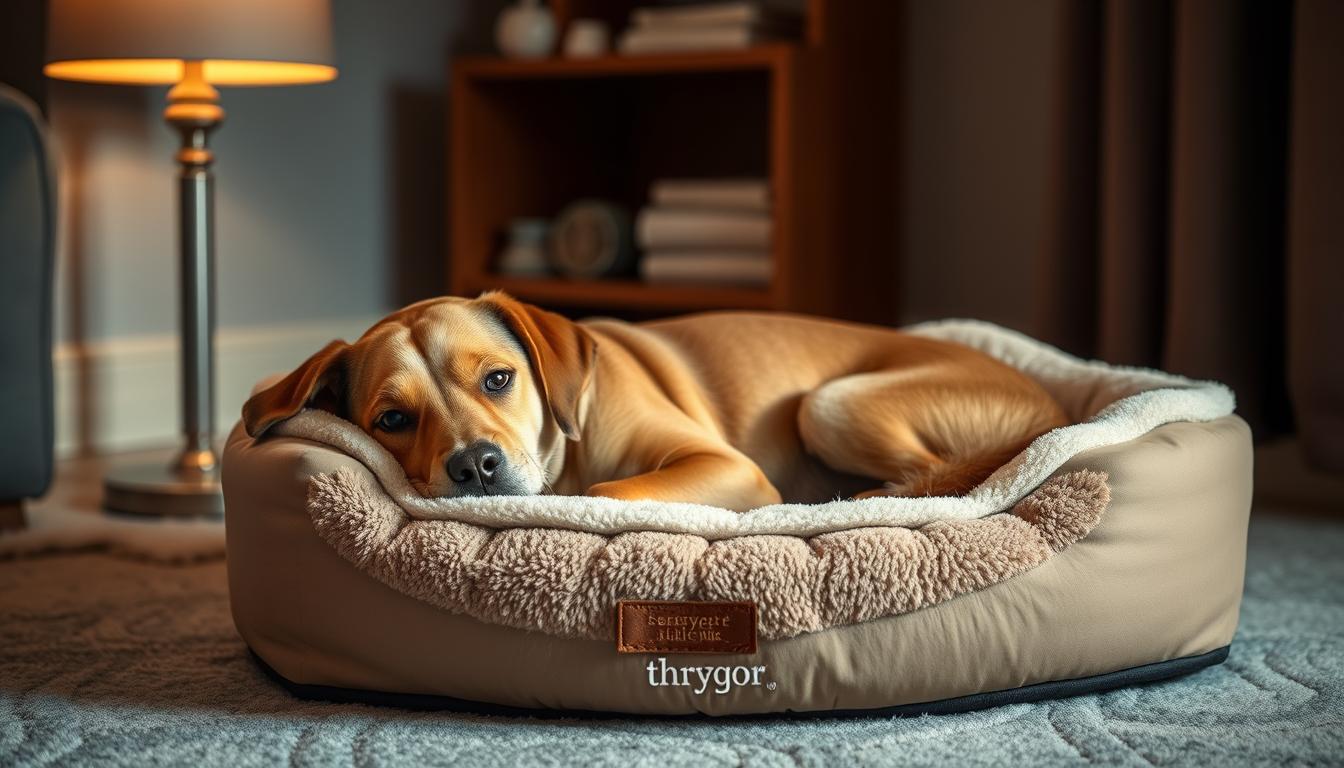You want your pet safe and cozy when temperatures drop. This short guide helps you pick the right gear for daily walks, weekend trips, and chilly nights at home. Think jackets, boots, reflective leashes, and warmer beds.

Brands like Ruffwear, L.L.Bean, Carhartt, and Tractor Supply Company offer tested options. Choose insulated beds that trap heat, fleece blankets that block moisture, and paw wax for rough sidewalks. For visibility, add reflective straps for early sunsets.
We’ll show how to match items to size, coat, and age so you make sure fit and comfort come first. You’ll also find tips on measuring, introducing new gear, and caring for paws after walks.
Key Takeaways
- Pick layered gear for short-fur or senior pets who need extra insulation.
- Use insulated beds and heated options for long nights and low temps.
- Protect pads with boots or paw wax after salty walks.
- Add reflective leashes or straps for low-light safety.
- Measure fit carefully and introduce new items slowly.
- Pack basics for winter outings so you both stay warm and safe.
Cold-weather buyer’s guide to keep your dog warm and safe
Choose gear that suits your dog’s build, coat type, and life stage before the first freeze. That first step makes shopping faster and keeps walks comfortable all winter months.
Match protection to breed, coat, and age
Start with breed and coat density. Small or short-haired breeds lose heat fast and often need sweaters or insulated jackets.
Puppies and seniors chill quicker than adults. Add layers and shorten outdoor time when needed. Make sure closures fit snugly without restricting movement.
Consider local weather, snow, ice, and daily walks
- Light layers work for brisk days; waterproof, insulated shells suit slush and sleet.
- Boots and paw wax help short fur and low‑body‑fat pets handle icy sidewalks and salt.
- For active dogs on many walks, pick durable, easy‑clean fabrics that last the year.
Check fit weekly, watch behavior for chills or lifted paws, and adjust layers as the weather changes. These small habits help keep dogs safe all season.
Cozy layers: sweaters, coats, and waterproof jackets
A good sweater plus a weatherproof shell covers most cold‑weather needs for small and short‑haired pups. Layering helps you keep walks short and comfortable, while giving extra warmth where it matters.
Warm sweaters for small breeds, short coats, pups, and seniors
Soft knit or fleece sweaters are ideal when temps fall below about 50°F. They give thin‑coated dogs, puppies, and seniors a quick heat boost without bulk.
Look for breathable knits like chunky cable styles (ALQO WASI) that trap warmth. Choose fabrics that fit snugly but do not rub under the legs.
Waterproof dog jackets to handle rain, snow, and icy weather
For wet days, add a waterproof jacket or quilted coat with insulation and sealed seams. Models such as Ruffwear Powder Hound, Paco & Lucia’s quilted coat, and L.L.Bean flannel sherpa vests offer weather resistance and warmth.
Priority features: belly coverage, leash/harness portal, reflective trim, and easy closures for fast dressing.
Fit, insulation, and leash/harness access to keep dogs comfy
- Measure neck, chest, and back length for a snug fit that still lets your dog move.
- Test range of motion—sit, lie down, and trot—so the cut won’t restrict shoulders or hips.
- Keep a dry backup layer by the door and wash technical outerwear per labels to maintain insulation and waterproofing.
Accessories to protect your dog in the cold
The right paw kit helps dogs move confidently through snow and slush. Focus on items that block wetness, add grip, and heal dry pads after long walks.
Rubber dog booties to shield paws from snow, ice, and salt
Pick rubber or water‑resistant booties that fit snugly and cover pads and toes. Models like WagWellies slip on securely with vented slits, while My Busy Dog boots offer a rugged, water‑resistant finish that keeps salt and ice off paws.
Paw wax for cracked paw pads and extra paw protection
Paw wax from brands like HOWND soothes dry, cracked pads and creates a barrier against snow and melt chemicals. Apply a thin layer before short outings or when boots aren’t practical.
Sizing, traction, and break-in tips for winter booties
- Measure each dog paw while standing to get full weight‑bearing width; front and rear sizes can differ.
- Choose soles with tread for traction on ice and packed snow.
- Start indoors with short sessions and reward your pet so booties feel fun, not strange.
- After walks, rinse paws with lukewarm water and dry between toes; reapply wax if pads feel dry.
Warm at home and on trips: beds, blankets, and insulated kennels
Make your dog’s indoor naps and travel stops cozy with beds and blankets designed for winter use. Choose items that trap body warmth and resist damp so your pet stays dry and comfortable.

Heated and insulated beds that trap heat
Insulated beds capture body heat and work well on drafty floors during the coldest part of the day.
Consider K&H heated outdoor beds for porches or campers; they offer orthopedic padding, water‑resistant covers, and low‑watt operation. PetSmart and Amazon carry plug‑in heated options and insulated models, including camo patterns for outdoor use.
Fleece-lined, waterproof blankets for cozy naps
Add a fleece blanket with a water‑resistant shell—Mambe and L.L.Bean make durable, easy‑clean choices that block damp and trap heat.
“A washable fleece layer extends insulation and makes travel simpler.”
Insulated kennels for brief outdoor stays
Insulated kennels reduce heat loss for dogs who linger outside, but limit exposure and bring pets inside when temperatures fall.
| Item | Best use | Key features |
|---|---|---|
| Insulated bed | Indoor & sheltered porches | Heat‑trapping fill, washable cover, raised base |
| K&H heated bed | Porches, campers | Orthopedic padding, water‑resistant, low‑watt plug |
| Fleece‑lined blanket | Travel & daily naps | Water‑resistant shell, machine wash, fleece loft |
| Insulated kennel | Short outdoor stays | Insulated walls, elevated floor, weatherproof |
- Pack a travel bed and blanket for trips so dogs settle quickly on cold floors.
- Rotate and wash blankets weekly to preserve fleece loft and limit odors.
- Elevate outdoor beds to cut ground chill and keep sleeping areas dry after snow melt.
Be seen on dark winter walks: reflective and safety gear
Short daylight means you need simple visibility tricks that work after dusk.
Clip on reflective leashes and LED add‑ons that light up under headlights. L.L.Bean sells especially bright reflective options for traffic or hunting areas. Ruffwear jackets include reflective details that boost dusk visibility.
Attach a light to both leash and harness so you are visible from multiple angles in mixed weather. Test visibility by stepping back 50–100 feet in your driveway and checking how easy it is for a driver to spot your friend.
- Choose bright reflective products and LED clip‑ons for high‑traffic routes.
- Keep a spare reflective leash in the glove box for surprise dusk walks.
- Clean reflective strips often; dirt dulls reflectivity and reduces safety.
Small habits matter: pair reflective gear with steady routes and clear crossings. These simple steps make evening walks safer for both you and your dogs.
| Item | Best use | Why it helps |
|---|---|---|
| Reflective leash | Street walks | Visible under headlights |
| LED clip‑on | Trailheads & parks | Active light for low light |
| Reflective jacket | Busy roads | 360° visibility |
Indoor winter wellness: enrichment toys and joint support
Keep cabin fever at bay with a mix of puzzle feeders, snuffle mats, and rubber toys that reward curiosity.

Rotate snuffle mats and puzzle feeders so each session feels new. Short scent circuits around the house replace one walk on days with a lot of snow.
Choose durable rubber toys with treat cavities, like the Beco bone, to keep noses busy and boredom low. Plan brief training games through the day to burn mental energy and add structure.
Joint support for stiffer days
If your dog slows in cold snaps, ask your vet about supplements that combine glucosamine HCl, MSM, green‑lipped mussel, and chondroitin.
This Dog’s Life Hip, Joint, and Arthritis chews offer more than 1,000 mg of active ingredients per chew and can help mobility across the year when started before the deepest cold.
- Rotate puzzle feeders and snuffle mats for variety.
- Swap a walk for an indoor scent game on icy days.
- Begin joint chews before the worst winter weather each year and track results over two to four weeks.
- Pair low‑impact play with warm‑up stretches and gentle massage to boost circulation after activity.
These small steps give your pet mental work, gentle movement, and comfort on a gray winter day.
Adventure-ready cold weather kit for your canine
When trails turn snowy, a compact kit keeps your canine ready for common outdoor mishaps.
Trail dog first aid essentials for cuts, ice, and emergencies
Pack a small first aid kit that includes bandages, dressings, tweezers, disinfectant, and a simple care guide. The Adventure Medical Kits Trail Dog First Aid Kit covers these basics.
Carry a paw‑care pouch with wax, wipes, and a spare sock bootie for ice balls between toes.
Packing checklist: boots, jacket, blanket, and heat-friendly bed
Stash a weather‑resistant jacket like the Ruffwear Powder Hound for quick warmth. Add My Busy Dog boots or booties that grip on packed snow and resist salt.
- Lightweight waterproof blanket (Mambe) for dry rest stops.
- Low‑watt heated or insulated bed (K&H) for overnights.
- ID tags and a GPS collar for low visibility sections.
| Item | Use | Why it helps |
|---|---|---|
| First aid kit | Minor cuts | Quick treatment on trail |
| Ruffwear jacket | Sudden chill | Insulated, water‑resistant |
| Boots/booties | Snow & salt | Grip and pad care |
| Heated bed | Overnight | Low watt, orthopedic warmth |
Do a backyard shakedown before longer trips: test fit, zips, and blanket roll so everything works when winter weather arrives.
Conclusion
,Simple routines and well‑chosen gear let you enjoy winter adventures without worry. Pack a reliable jacket and fit tested boots before short snow walks. Add a warm bed and waterproof blankets for cozy downtime.
Focus on paw care: keep wax, wipes, and rubber booties by the door. Rinse pads after icy routes and reapply balm when needed. Match items to breed and fur so layers work well through sudden weather swings.
Choose trusted products—K&H heated beds, Mambe or L.L.Bean blankets, Ruffwear jackets, WagWellies or My Busy Dog boots, and HOWND wax—and bring a small first aid kit for trips. With these steps you help keep pup safe, warm, and ready for winter months.
FAQ
How do I match cold-weather gear to my dog’s breed, coat, and age?
Assess your pup’s fur type, body fat, and age. Short-coated breeds, tiny dogs, puppies, and seniors usually need more insulation like a fleece sweater or insulated jacket. Thick-coated breeds may only need a lightweight shell for wet or icy conditions. Always prioritze fit and mobility so your dog can move, eat, and potty comfortably.
What should I consider for local weather, snow, ice, and daily walks?
Check temperature, wind chill, and whether sidewalks are salted. For light cold and dry walks, a sweater might suffice. In wet, snowy, or icy weather choose a waterproof jacket and booties. Shorten walk times in frigid temps and dry paws and pads after every outing to prevent cracking and irritation.
When should I use a warm sweater versus a waterproof dog jacket?
Use a warm sweater for indoor chill or short outdoor outings on dry, cold days. Choose a waterproof jacket when it’s raining, sleeting, or snowing—those keep fur dry and block wind. For many dogs, layering a sweater under a waterproof shell gives the best warmth and protection.
How do I pick the right dog booties for snow, ice, and salt?
Look for booties with a secure closure, durable rubber or TPU soles, and good traction. Size them to fit snugly without cutting circulation. Break them in with short indoor sessions before long walks. Rinse paws after walks to remove salt and chemicals that can burn pads.
Is paw wax a good alternative to booties?
Paw wax can help by creating a protective barrier against snow and salt and by moisturizing cracked paw pads. It works best for short walks or dogs that refuse booties. For deep snow, sharp ice, or long hikes, booties offer superior mechanical protection and traction.
How do I measure my dog for coats, sweaters, and booties?
Measure neck circumference, chest girth (widest part behind front legs), and back length from base of neck to tail. For booties, measure paw width across the widest part while the dog stands. Follow each brand’s sizing chart and opt for adjustable straps when between sizes.
What bedding and blankets keep a pup warm at home or on trips?
Heated or insulated dog beds trap body heat and reduce the need for high room temperatures. Fleece-lined, waterproof blankets add comfort and a dry surface indoors or in a crate. For travel, pack a compact insulated bed or thermal blanket to maintain warmth through nights and rest stops.
Are insulated kennels necessary if my dog stays outdoors sometimes?
If a dog spends significant time outdoors in winter, an insulated kennel reduces heat loss and blocks wind. Ensure the shelter is elevated, has a wind-facing entrance shield, and contains bedding that stays dry. Do not rely solely on insulation for extreme cold; bring the dog indoors whenever possible.
What visibility gear helps on short winter walks when it gets dark early?
Choose reflective leashes, LED collars, and clip-on lights for coats and harnesses. High-visibility colors and reflective strips improve safety for drivers and cyclists. Layer illumination—collar light plus jacket reflectors—for best visibility in low light.
How can I keep an indoor dog mentally and physically healthy during winter?
Introduce puzzle feeders, snuffle mats, and durable rubber toys to reduce boredom. Short indoor training sessions and scent games boost activity without long outdoor exposure. For older dogs, consider joint supplements after consulting your vet to ease stiffness aggravated by cold.
What should I include in an adventure-ready cold-weather kit for my canine?
Pack booties, a waterproof jacket, a warm blanket or compact insulated bed, a first-aid kit with wound care for cuts and cold-related injuries, extra water, and high-energy treats. Add a leash, collar ID, and a dog-safe heat pack for long trips or emergencies.
How do I handle paw injuries from ice or salt during winter hikes?
Clean wounds with saline, apply a pet-safe antiseptic, and protect the area with a bootie or bandage until it heals. For heavy bleeding or deep cuts, seek veterinary care. Prevent injuries by using booties, shortening hikes on icy trails, and checking paws often for embedded ice or abrasions.